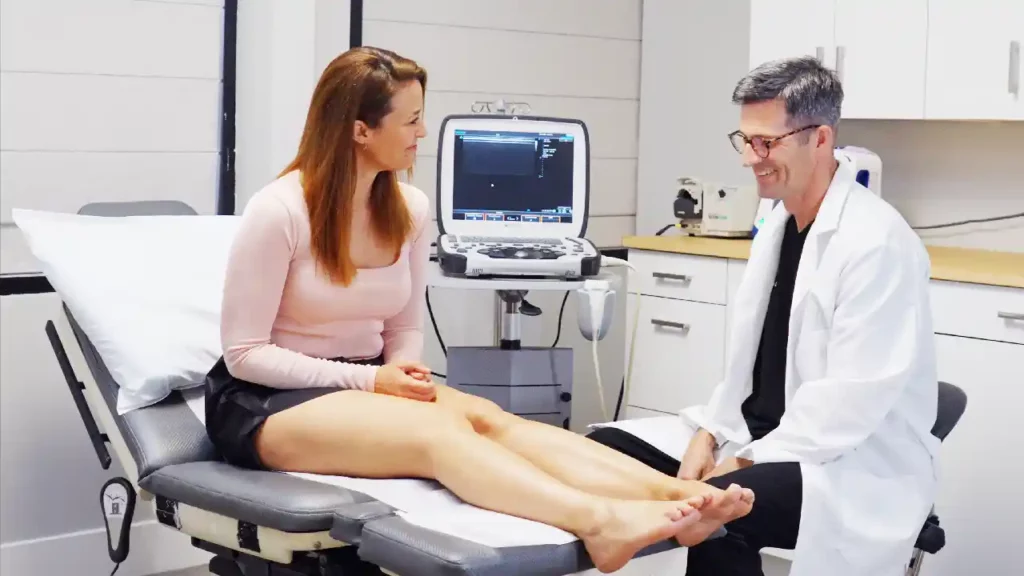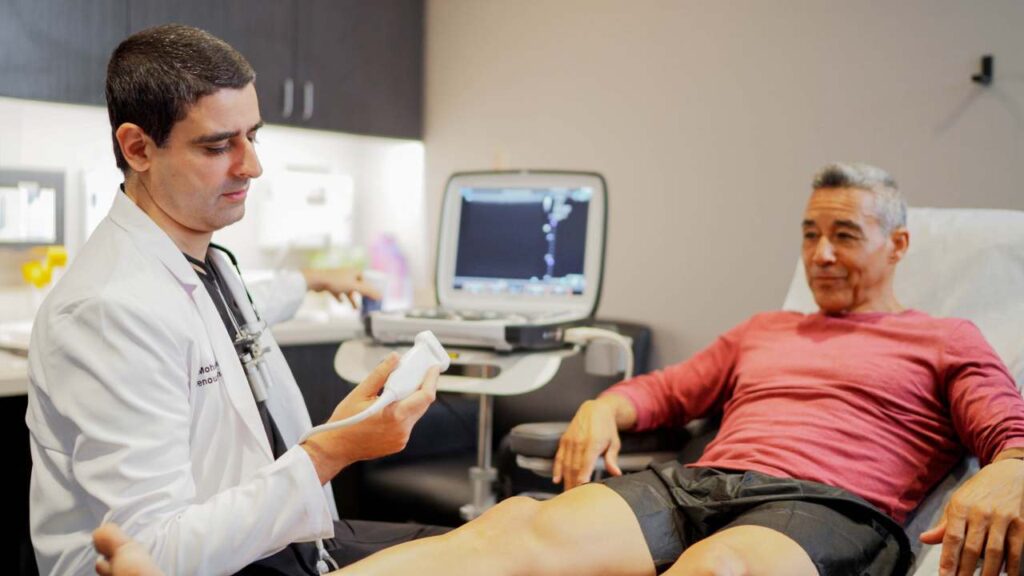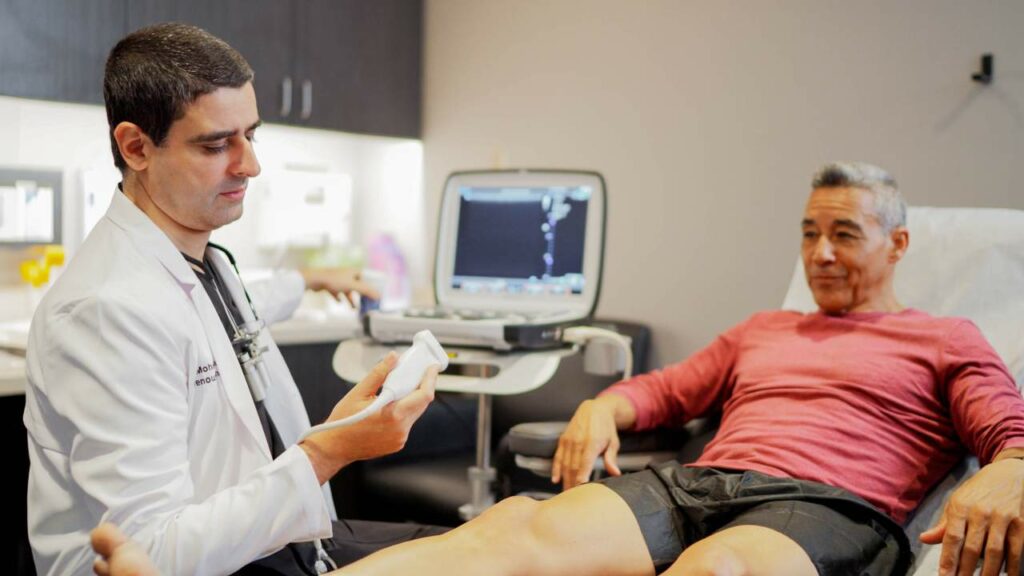Step 1: Initial Consultation
Your varicose vein treatment in California starts with a consultation. You must identify the best vein doctors or vein centers for your treatment — inexperienced vein doctors often treat the visible varicose veins without diagnosing the underlying venous insufficiency, leading to a high risk of recurrence. Vein Treatment Clinic has a flawless track record with advanced varicose vein treatments, as evidenced by our 5-star ratings and reviews. Our state-of-the-art vein center is located at 5330 Carroll Canyon Rd Suite 140, close to the popular Torrey Pines beach state park. You may schedule a consultation online or call us at +1 858-461-7886.
During your initial consultation, our vein doctors will carefully examine your leg veins, review your medical history, and discuss your symptoms. They might ask you if you’re experiencing leg heaviness, restless leg syndrome, frequent leg cramps, leg pain, or other similar symptoms. They’ll also ask you if the symptoms worsen at the end of the day or after long periods of inactivity — this is a strong indicator of underlying vein disease. Understanding your medical history and symptoms is important because it allows us to determine your risk of venous insufficiency, which, in turn, allows us to curate a treatment plan that addresses the root cause of your vein problems.
Step 2: Diagnosis
The initial consultation and examination is followed by the diagnostic process. Our vein doctors use the latest vascular imaging techniques, such as Duplex Ultrasound, to conclusively determine if you have venous insufficiency. Duplex Ultrasound is a vascular imaging test that provides a visual representation of the direction of blood flow in your leg veins. This allows the vein doctors to determine if you have venous insufficiency and, if so, then identify the diseased saphenous vein responsible for your troubles.
Step 3: Treatment Plan
After the diagnosis, the vein doctor discusses your varicose vein treatment options. They discuss the pros/cons of all your vein treatment options, including their costs, recovery process, and insurance coverage options. We recommend the ideal varicose vein treatments based on your specific diagnosis, cosmetic goals, and insurance coverage options, but the final decision rests in your hands. We empower you to make an informed decision about your vein treatment. However, we only provide minimally invasive vein treatments with a high success rate and a negligible risk of complications. You can rest assured that all the vein treatments will be painless, quick, and involve no downtime.
Step 4: Primary Treatment
The “primary treatment” refers to the initial round of treatments for the underlying venous insufficiency. This step is only necessary for patients with underlying venous insufficiency. If you don’t have underlying vein disease, you can move to cosmetic treatments directly. The primary treatments include radiofrequency ablation, endovenous laser ablation, or VenaSeal. These procedures have the same underlying goal, i.e., to collapse the diseased saphenous vein and restore healthy blood circulation, but they accomplish it through different methods.
Radiofrequency Ablation
Radiofrequency ablation is a minimally invasive procedure that uses thermal energy to treat vein disease. The vein doctor makes a small incision on the skin’s surface to insert a catheter into the diseased saphenous vein under ultrasound guidance. The catheter delivers thermal energy into the diseased vein to shut it down and restore smooth blood circulation to the heart.
Endovenous Laser Ablation
Endovenous laser ablation is a minimally invasive procedure that uses laser energy to treat vein disease. The vein doctor makes a small incision on the skin’s surface to insert a laser fiber into the diseased saphenous vein under ultrasound guidance. The endovenous laser delivers laser energy into the problematic vein to close it down, rerouting the accumulated blood to healthier leg veins.
VenaSeal
VenaSeal is a minimally invasive procedure wherein medical-grade adhesives are used to treat vein disease. The vein doctor injects a medical adhesive or vein glue into the diseased vein under ultrasound guidance. The diseased vein’s walls seal shut, and the accumulated blood reroutes to healthier leg veins.
Step 5: Cosmetic Treatment
Cosmetic treatment involves removing the superficial varicose veins and spider veins from the skin’s surface using various methods. The primary vein treatments address the underlying problem, but they don’t necessarily remove the visible spider veins on the skin’s surface. As such, the cosmetic treatments improve the aesthetic appearance of your legs, restoring your confidence. Ambulatory phlebectomy and sclerotherapy are widely considered the best vein treatments for superficial varicose veins and spider veins.
Ambulatory Phlebectomy
The vein doctor makes small incisions on the skin’s surface to manually extract and remove the superficial varicose veins. The small incisions eventually heal and turn into scars that gradually fade away.
Sclerotherapy
The vein doctor injects a special sclerosing solution into the spider veins. Sclerosant fuses the spider veins’ walls, turning them into hardened scar tissues that eventually get absorbed by the body and fade away from the skin’s surface. The spider veins will gradually fade away over 2 to 3 weeks, but you might need multiple sessions for optimal results. The vein doctor will curate the ideal treatment frequency and plan according to your needs.
Step 6: Recovery
After the vein treatments, the vein doctor will discuss your post-treatment recovery guidelines. You can resume most of your daily activities and work immediately, but you have to make a few lifestyle changes to ensure optimal recovery. The following are some of your guidelines:
- Wear compression stockings for a few weeks.
- Walk frequently — take regular walking breaks if you have a desk job.
- Engage in exercises that work your calf muscles, such as running, swimming, etc.
- Elevate your legs while sitting down to increase blood flow to the heart.
- Avoid heavy workouts and heavy lifting for a few days.





